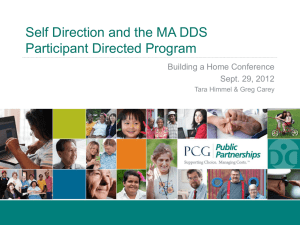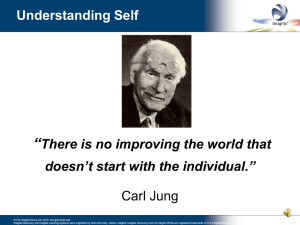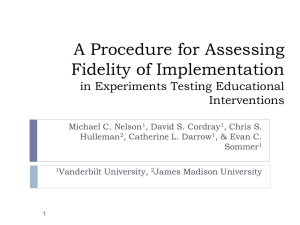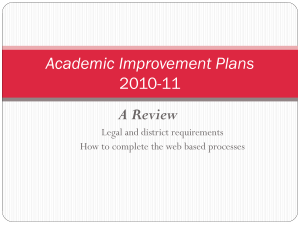Fidelity Management - Holifield & Associates, PLLC
advertisement
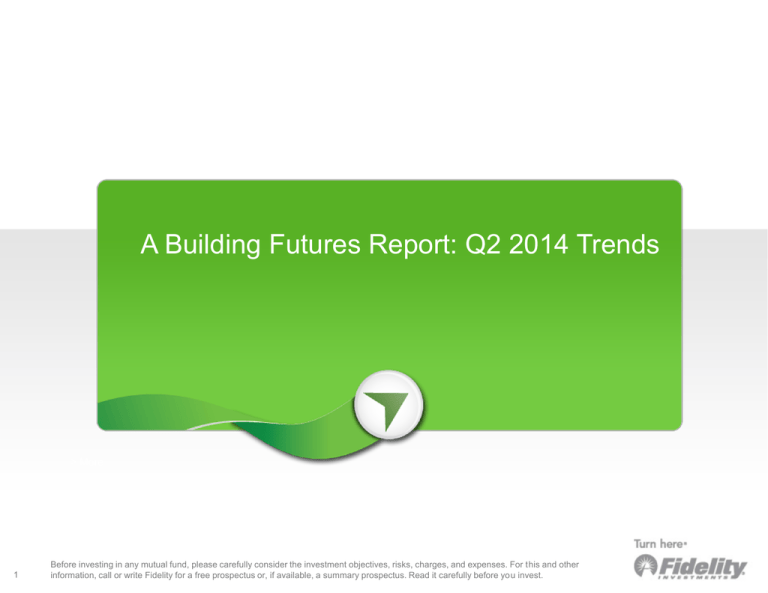
“No Image” Cover Page A Building Futures Report: Q2 2014 Trends > More 1 Before investing in any mutual fund, please carefully consider the investment objectives, risks, charges, and expenses. For this and other information, call or write Fidelity for a free prospectus or, if available, a summary prospectus. Read it carefully before you invest. Transition Page Fidelity Investments: An industry leading retirement provider Fidelity’s recordkept database is one of the industry’s most comprehensive proprietary collections of defined contribution plan and participant information. ► Based on recordkept data of corporate defined contribution (DC) plans: 21,200 plans 13.0 million participants ► Data as of June 30, 2014 unless otherwise noted1 > More 1 2 Data in this presentation exclude tax-exempt plans, nonqualified plans, and the FMR Co. plan. This analysis includes data from the Fidelity Advisor 401(k) Program. Account Balance Key Insights ► Currently, the average account balance is $91,000, an increase of 12.9% from one year prior. ► The median participant account balance is $24,900. ► Account balances are impacted by participant action (contributions, withdrawals, etc.) and market action. > More ► Account balances are also impacted by new participants having lower account balances than departing participants who may roll out their assets. 3 Account Balance (10-Yr Continuous Active Participants) Key Insights ► The 10-Year Continuous Active Account Balance follows the same participants over time to show what they experienced during the last ten years. ► These participants had a $246,200 average account balance, up from $60,800 ten years prior (15.0% > More annual increase). ► This account balance increase was 45% due to participant action (net contributions) and 55% due to market increases. 4 Continuous Active Participants are actively employed with a balance for each year endpoint during the 10-year period. Deferral Rates Key Insights ► The average employee deferral rate has remained steady for five years. ► Currently, the average employee deferral rate is 8.0%. ► Other > More than participant actions of increasing/decreasing deferrals (next slide), this figure is impacted by new participants joining the plan having lower deferral rates than departing participants leaving the plan. 5 Active Participants Only. Mean elective total deferral rates (point-in-time). Some figures may not add due to rounding. Changes to Employee Deferral Rates Key Insights ► Overall, 7.2% of participants made an employee deferral increase in the prior 3-months. ► In plans that offer Auto-AIP, 10.0% of participants had employee deferral increases in the prior 3-months. ► The long-term trend of more employee deferral increases than decreases was interrupted during Q3’08 > More Q1’09, but has resumed since (20 consecutive quarters). ► Annual Increase Program (AIP) is a big driver of this trend, see “Deferral Increases due to AIP” slide. 6 Continuous Active Participants Only (3-month). Mean elective total deferral rates (point-in-time). Employee Deferral Increases due to AIP Key Insights ► Annual Increase Program (AIP) was responsible for 26.4% of deferral increases made in the prior quarter. ► AIP represented about one-in-three (38.4%) of all deferral increases in prior 12-months. ► The seasonality is due to the majority of AIP increases occurring in Q1. > More 7 Continuous Active Participants Only (3-month). Auto-Enrollment (AE) Impact to Participation Rate Key Insights ► Younger, less well-compensated employees benefit from Auto-Enrollment (AE). ► The overall active participation rate is 68.0%, up from 64.1% five years prior due to impact of AE. ► In plans who offer AE, the participation rate is 84.3%, which has also increased as more employees become > More eligible for AE within those plans. ► Further, those employees who are eligible for Auto-Enrollment in AE Plans have a participation rate of 90.2% (i.e. only 9.8% opt-out). 8 Data as of 12/31/2013. Active Eligible Employees Only. Asset Allocation Key Insights ► Changes in asset allocation can be driven by market fluctuations, as well as by exchange, contribution, and withdrawal activity. ► Equity = Domestic Equity, International Equity, Company Stock, Specialty, Self-Directed Brokerage > More ► Blended = Target Date Funds, Target Risk Funds, Balanced Funds ► Conservative = Short-Term, Stable Value, Fixed Income, Annuity 9 Data in this presentation exclude tax-exempt plans, nonqualified plans, and the FMR Co. plan. This analysis includes data from the Fidelity 100% or 0% Equity Allocations Key Insights ► For many participants, equity allocation was an “all-or-nothing” decision. ► Mainly through the increased use of Target Date Funds, fewer participants now hold such extreme portfolios. > More ► Less than one-in-six participants (15.2%) hold 100% or 0% equity allocations. 10 Data in this presentation exclude tax-exempt plans, nonqualified plans, and the FMR Co. plan. This analysis includes data from the Fidelity Target Date Fund Adoption Key Insights ► About one-in-three total participants (35.7%) holds 100% of their assets in Target Date Funds. ► For Millennials (Gen Y), this figure is 55.2%. ► This > Moretrend has been chiefly driven by the use of Target Date Fund (TDF) Default. ► Default options have a sizeable impact on aggregate participant behavior. 11 Generation Y was born between 1979 – 1991. Personal Rate of Return (PRR)* Key Insights ► The median cumulative participant 1-year personal rate of return (PRR) is 19.4%. ► The median cumulative participant 3-year personal rate of return (PRR) is 34.1% (10.3% annualized). ► The median cumulative participant 5-year personal rate of return (PRR) is 91.5% (13.9% annualized). > More ► The median cumulative participant 10-year personal rate of return (PRR) is 88.7% (6.6% annualized). 12 * See Important Additional Information for more details. Personal Rate of Return (PRR)* 10-Year Participant Performance vs. Applicable Fidelity Freedom Fund® Lower Higher 10-Year Risk* Higher 38.6% 17.9% of Participants of Participants 56.5% of Participants 10-Year Return Lower 13.9% 29.6% of Participants of Participants 47.5% of Participants 43.5% of Participants 52.5% of Participants Key Insights ► Balanced portfolios such as the Fidelity Freedom Funds® outperformed 43.5% of participants over the 10year return period. ► Also, 52.5% of participants took on more risk. Of those with higher risk, 26.4% underperformed against their > More age-based Freedom Fund (13.9% / 52.5%). ► During the 10-year return period, the median participant cumulative return was 88.7% (or 6.6% annualized). 13 “Return” is the time-weighted 10-year cumulative return. “Risk” is the standard deviation of returns, a measure of the volatility of returns. “Applicable” Freedom Fund is the one with the closest target date given the participant’s date of birth, assuming a retirement age of 65. How to read: the top left box would indicate the percent of participants who had higher returns and lower risk (standard deviation of returns) than their applicable Freedom Fund over the 10-year return period. * See Important Additional Information for more details. Contribution Allocation Key Insights ► Changes in contribution allocation are driven by participant behavior, whereas asset allocation is heavily impacted by market movement. ► Equity = Domestic Equity, International Equity, Company Stock, Specialty, Self-Directed Brokerage (SDB) > More ► Blended = Target Date Funds, Target Risk Funds, Balanced Funds ► Conservative = Short-Term, Stable Value, Fixed Income, Annuity 14 Active Participants Only. Employee Contributions Key Insights ► In the prior 12-months, 86.7% of active participants made employee contributions, up from 82.0% ten years prior. ► Also, 84.7% of active participants received employer contributions in the prior 12-month period (not > More graphed). ► Overall, 93.9% of active participants made contributions (employee, employer, or roll-in) in the prior 12month period (not graphed). 15 Active Participants Only. Average Contribution Amounts Key Insights ► The average 12-month employee contribution was $6,050, up from $4,910 ten years prior (per participant making >$0 employee contributions). ► This represents a 2.1% annual increase in employee contribution amounts. > More ► The average 12-month employer contribution was $3,540, up from $2,450 ten years prior (per participant receiving >$0 employer contributions). ► This represents a 3.7% annual increase in employer contribution amounts. 16 Active Participants Only. Plan Design Key Insights ► Plans offering Auto-Enrollment (AE) has increased to 26.5% of plans, representing 59.7% of the participant base. ► Plans offering Roth Deferrals has increased to 46.6% of plans, representing 65.7% of the participant base. > More ► Also, 77.3% of plans offer Annual Increase Program (AIP) and 12.3% of plans offer Auto-AIP (not graphed). ► Also, 81.7% of plans have Target Date Fund (TDF) Default, up from 65.5% five years prior (not graphed). 17 Loans Outstanding Key Insights ► The percent of active participants with a loan outstanding is 22.5%. ► The percent of active participants initiating a loan in the prior 12-months is 10.7%. > More 18 Data in this presentation exclude tax-exempt plans, nonqualified plans, and the FMR Co. plan. This analysis includes data from the Fidelity Hardship Withdrawals Key Insights ► While hardship withdrawals (HWs) continue to increase, they represent a very small portion of active participants. ► The percent of active participants taking a hardship withdrawal was 2.3% in the prior 12-months. > More ► In order to take a hardship withdrawal, you have to prove a financial need. ► Examples of reasons for HWs: 1) foreclosure, 2) tuition, 3) purchase of primary residence, 4) medical expenses. 19 Active Participants Only. Exchanges Key Insights ► In the prior 12-months, 10.5% of participants made an exchange. ► One reason for this long-term decline is the continued adoption of Target Date Funds (TDF). ► Only > More1.6% of participants who held 100% of assets in TDFs made an exchange in the prior 12-months. ► See Target Date Fund Adoption slide for more. 20 Exchanges In/Out of Equities Key Insights ► This figure tracks the percent of exchanging participants who had net exchanges into equities, minus the percent of exchanging participants who had net exchanges out of equities in each 3-month period. ► Negative figures indicate that more participants exchanged out of equities than into equities during the > More period. ► Exchanges in/out of equities largely track the movements of the equity markets. 21 Participant Demographics – Age Wave Key Insights ► The median age for participants was 45.5, up from 44.3 ten years prior. ► The median tenure for active participants is 7.4 years, while the mean tenure is 10.2 years. ► The median salary for active participants is $65,600, while the mean salary is $90,400. > More 22 Active Participants only for tenure and salary figures. Important Additional Information Before investing in any mutual fund, please carefully consider the investment objectives, risks, charges, and expenses. For this and other information, call or write Fidelity for a free prospectus or, if available, a summary prospectus. Read it carefully before you invest. As with all your investments through Fidelity, you must make your own determination whether an investment in any particular security or securities is consistent with your investment objectives, risk tolerance, financial situation and your evaluation of the security. Dollar cost averaging does not ensure a profit or protect against loss in a declining market. For the strategy to be effective, you must continue to purchase shares in both up and down markets. Personal Rate of Return (PRR): A measure of portfolio performance that indicates the return earned over a given time period. Personal rate of return used in our analyses (unless otherwise noted) is time weighted, which means it was calculated by subtracting beginning market value from ending market value and dividing by beginning market value for each sub-period. A new sub-period began each time there was cash flow. The sub-period returns were then geometrically linked together to calculate the return for the entire period. All returns shown are historical and include change in share value and reinvestment of dividends and capital gains, if any. Risk is defined as the volatility of historical portfolio returns; it measures the average deviation of a series of historical returns from its mean. Large values of risk indicate large volatility in the historical return series, and small values indicate low volatility. Stock markets, especially foreign markets, are volatile and can decline significantly in response to adverse issuer, political, > Moremarket, or economic developments. regulatory, Keep in mind investing involves risk. The value of your investment will fluctuate over time and you may gain or lose money. Past performance is no guarantee of future results. 23 Important Additional Information Fidelity Freedom Funds® are designed for investors expecting to retire around the year indicated in each fund's name. Except for the Freedom Income Fund the funds' asset allocation strategy becomes increasingly conservative as it approaches the target date and beyond. Ultimately, they are expected to merge with the Freedom Income Fund. The investment risks of each Fidelity Freedom Funds® change over time as its asset allocation changes. They are subject to the volatility of the financial markets, including equity and fixed income investments in the U.S. and abroad and may be subject to risks associated with investing in high yield, small cap and, commodity-related, foreign securities. Principal invested is not guaranteed at any time, including at or after their target dates. For plan sponsor and institutional use only. > More Fidelity Brokerage Services LLC, Member NYSE, SIPC, 900 Salem Street, Smithfield, RI 02917 Fidelity Investments Institutional Services Company, Inc., 500 Salem Street, Smithfield, RI 02917 668559.4.0 24






